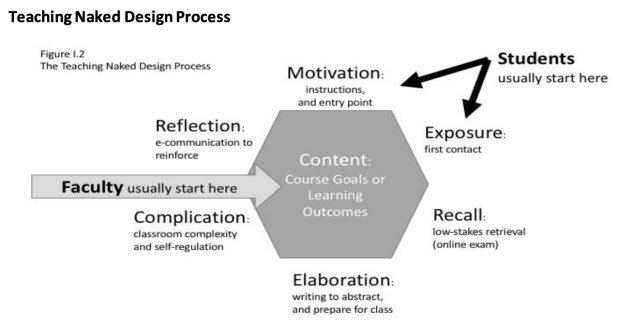 This post highlights a variety of tips from the book entitled: “Teaching Naked Techniques: A Practical Guide to Designing Better Classes” by José Antonio Bowen and C. Edward Watson.
This post highlights a variety of tips from the book entitled: “Teaching Naked Techniques: A Practical Guide to Designing Better Classes” by José Antonio Bowen and C. Edward Watson.
See also: Teaching Naked with Technology
“A fitness coach understands the human body and the individual subject, but also the equipment in the gym.
Technology is bringing new tools and new competition to higher education, but it is also changing the base rules about how we operate as human beings.”
- Technology is a tool of which, the goal is to increase learning
- The focus should not be on the delivery of content, rather, how can we best increase faculty-student interaction, design and sequence enhanced learning experiences, elevate students to the application/analysis/synthesis of information, and increase the motivation of students.
- Technology makes course design and pedagogy more important
- The role of technology is to create more time and generate more valuable opportunities for face-to-face
- Faculty can leverage social media to connect ideas outside of the classroom
“In fact, if you don’t ever contact students outside class, you are reinforcing the idea that the information in your class is not relevant to the ‘real world’.”
First Exposure
- TIP: Make learning goals transparent to students and create rubrics (See Blackboard Interactive Rubrics) improve visibility and give students a target and checklists help students stay on track.
- TIP: Use online content such as creating your own video content (Panopto/Lightboard) and be sure to use closed captions, and take advantage of open educational resources, for first student exposure
![]() Learn more about using Panopto and the lightboard to create engaging and motivating instructional video content in your teaching at GVSU. Use Blackboard interactive rubrics to make grading easier and to create student awareness of learning outcomes and assignment expectations.
Learn more about using Panopto and the lightboard to create engaging and motivating instructional video content in your teaching at GVSU. Use Blackboard interactive rubrics to make grading easier and to create student awareness of learning outcomes and assignment expectations.
Entry Point
So… where do YOU begin? Where do your STUDENTS begin?
- Students start at “why do I care and why does this matter”? Good teaching always starts with what matters to students… and ends with what matters to you.
- Don’t ignore, rather, place your focus on the entry point of instruction
- Discover what your students care about, what they are motivated by, and what they already know
- Use opportunities to engage students with content and why it matters to students
Pre-Class Online Quizzes, Discussions, and Learning Activities
- TIP: Use frequent pre-class quizzes, online exams, discussions and learning activities to improve student preparation for class – with feedback
- TIP: Use student performance on these quizzes as an opportunity to guide classroom time
![]() Learn more about using Blackboard to create online quizzes, assignments, discussions, and learning activities at GVSU.
Learn more about using Blackboard to create online quizzes, assignments, discussions, and learning activities at GVSU.
- Benefits of low stakes testing: aids retrieval and retention, identifies gaps in knowledge, students learn more when they study, produces organization of learning, improves transfer of knowledge, improves metacognitive monitoring, provides feedback to instructors and students, encourages students to study.
- Low stakes assessments are critically important for students and they are much less likely to encourage cheating
“Limit the length of lectures, break up class time into active learning activities, leverage class time for connection, community, and relationships…”
Give Students Prompt and Detailed Feedback
- Be sure your learning goals are linked to your learning activities and finally outcomes assessment
- Provide clear goals and use rubrics and give feedback
“Learn to use your online gradebook – enter grades directly into your LMS (Blackboard) and include feedback…”
![]() Learn more about using Blackboard’s grade center at GVSU to provide feedback to students.
Learn more about using Blackboard’s grade center at GVSU to provide feedback to students.
- Best practices in providing feedback include: frequent, immediate, discriminating (specific), and loving.
Use eCommunication Technologies to Connect with Students
- Use a variety of electronic communication technologies to reach students
- Increase your social presence
- Add a social media presence to connect with students outside of class
- Use your LMS (Blackboard) and email to provide a supportive presence to students
Ensure Student Success with Retention and Intervention
Technologies are proving successful at increasing the quality of instruction and improving student success rates across a number of metrics.
- Learning and analytics tools embedded in the LMS (Blackboard) reveal predictive patterns and provide intervention opportunities for students at risk
![]() Learn more about Blackboard’s Retention Center and Performance Dashboard at GVSU as learning analytics tools to monitor students and intervene with students “at risk”.
Learn more about Blackboard’s Retention Center and Performance Dashboard at GVSU as learning analytics tools to monitor students and intervene with students “at risk”.
S-W-E-E-T
- Encourage students to use SWEET:
- S – Students need Sleep
- W – Students need to drink Water
- E – Students need to Eat well
- E – Students need Exercise
- T – Students need to manage their Time
Remember: “A single professor can make a massive difference in a student’s life.”
- Significant student impact can be found with a professor who: 1) CARES about the student as a person, 2) MAKES students excited about learning, and 3) ENCOURAGES students to pursue their dreams.
How about you?
What techniques do you find as beneficial to aid in student learning and success?
